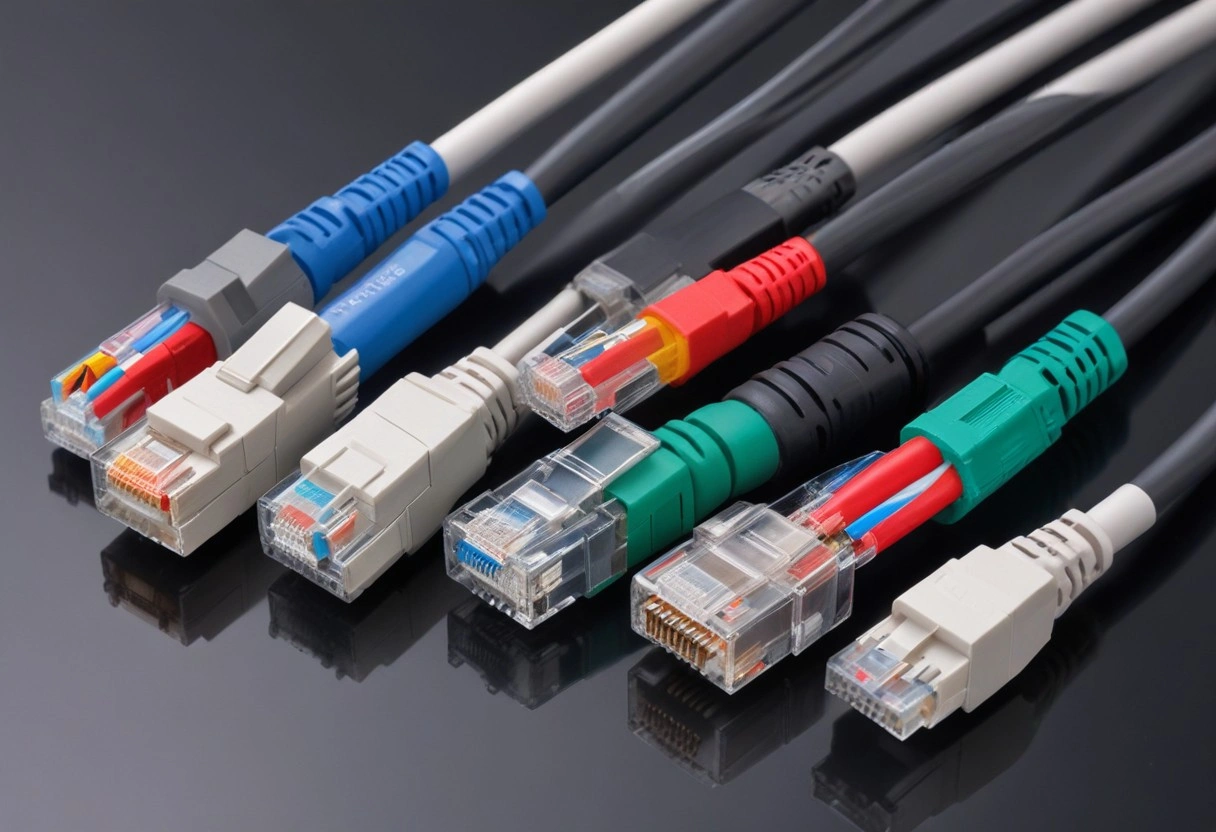Types of network cables
Network cables are essential for the setup and functioning of any network
Created by: Daniel Ogunsemowo /
Vetted by:
Otse Amorighoye

Understanding Network Cables: Types and Uses
Network cables are essential for the setup and functioning of any network. They enable the connection and communication between computers, servers, and other network devices. Here are the primary types of network cables used in networking:
Types of Network Cables
1. Twisted Pair Cables
Twisted pair cables are the most common type of cabling used in local area networks (LANs) and other telecommunications setups. They consist of pairs of insulated copper wires twisted together to reduce electromagnetic interference.
Unshielded Twisted Pair (UTP)
This is the most commonly used twisted pair cable in office and home networks. It relies on the twisting of the cables to provide protection from electromagnetic interference.
Shielded Twisted Pair (STP)
This cable includes shielding in the form of a foil around each pair of wires or around the group of wires to provide additional protection from interference.
2. Coaxial Cable
Coaxial cable, or coax, is made of a single solid copper core. A plastic layer provides insulation between the center conductor and a metal shield. This cable is traditionally used for television and other broadband networks due to its ability to carry high-frequency signals over long distances without significant loss.
3. Fiber Optic Cable
Fiber optic cables use glass fibers to transmit data as pulses of light. They offer high bandwidth, can support data transmission over long distances, and are immune to electrical interference. Fiber optic cables are ideal for backbone connections between networked buildings or within data centers.
Single-mode Fiber
Uses a single ray of light (mode) to carry transmission over long distances.
Multi-mode Fiber
Uses multiple rays of light simultaneously, which gives high bandwidth at high speeds over medium distances.
For more detailed information, refer to Advantages of Using Fiber Optic Cabling for a Network.
4. Ethernet Crossover Cable
A crossover cable is a type of twisted pair cable that reverses the transmit and receive signal pins. It is used to connect two similar devices directly, such as a computer to a computer or a switch to a switch without needing a switch or hub in between.
5. Cat5e, Cat6, Cat6a, and Cat7 Cables
These are specific types of twisted pair Ethernet cables, each with different specifications and capabilities.
Cat5e
Supports speeds up to 1 Gbps (Gigabit Ethernet) and bandwidth up to 100 MHz.
Cat6
Supports speeds up to 10 Gbps and bandwidth up to 250 MHz.
Cat6a
Supports speeds up to 10 Gbps and bandwidth up to 500 MHz, with improved specifications over Cat6, especially in terms of crosstalk and system noise.
Cat7
Supports speeds up to 10 Gbps and bandwidth up to 600 MHz and includes additional shielding for each pair of wires.
For more on selecting the right Ethernet cable, visit Ethernet Cable Management Tips
6. Patch Cables
Patch cables are used for short distances within a server room or data center, typically to connect switches, routers, and servers to each other. They are usually made of twisted pair cabling with RJ-45 connectors.
Using Ethernet Cable Management Tips can help in maintaining order with patch cables.
7. Bulk Cables
Bulk cables refer to the purchase of large quantities of cable without connectors, allowing network technicians to create custom cables suited to specific networking needs.
Conclusion
The type of network cable selected for a project depends on the network's specific needs, including required speed, distance, and environmental factors such as potential interference. By understanding the different types of network cables and their uses, IT professionals can ensure optimal network design and functionality. Not sure which cable is right for your needs? Learn how to choose the best network cabling solution for you by downloading our free template here.
FAQs
1. What is the most common type of network cable used in homes and offices?
The most common type of network cable used in homes and offices is the Unshielded Twisted Pair (UTP) cable.
2. What are the advantages of using fiber optic cables?
Fiber optic cables offer high bandwidth, support data transmission over long distances, and are immune to electrical interference.
3. What is the purpose of a crossover cable?
A crossover cable is used to connect two similar devices directly, such as a computer to a computer or a switch to a switch, without needing a switch or hub in between.
4. What is the difference between Cat6 and Cat6a cables?
Cat6 cables support speeds up to 10 Gbps and bandwidth up to 250 MHz, while Cat6a cables also support speeds up to 10 Gbps but with a higher bandwidth of up to 500 MHz and improved specifications for crosstalk and system noise.
5. Why are bulk cables used by network technicians?
Bulk cables are purchased in large quantities without connectors, allowing network technicians to create custom cables suited to specific networking needs.
Further Reading
Looking to optimize your network with top-quality cabling solutions? Whether you're building from the ground up or enhancing an existing setup, choosing the right cables is key to maximizing performance. Get in touch with us today—simply Contact us and one of our experts will promptly connect with you to help bring your project to life!